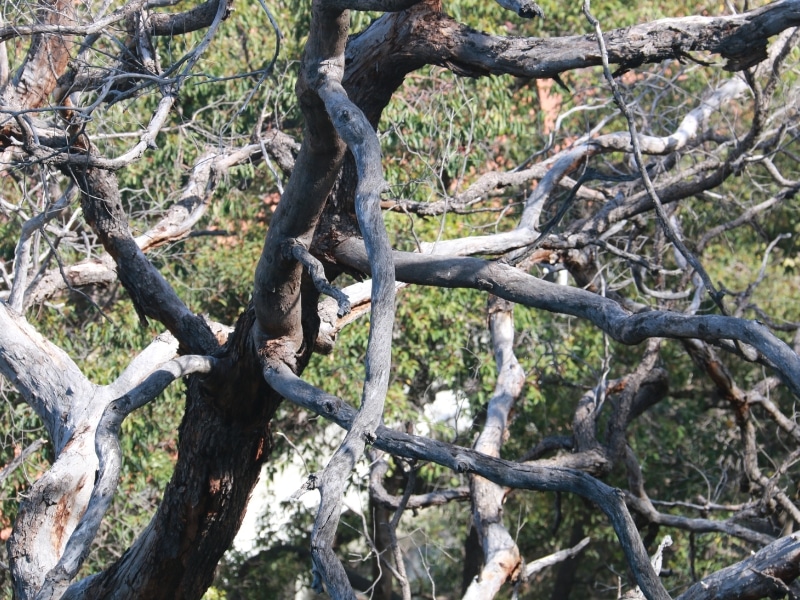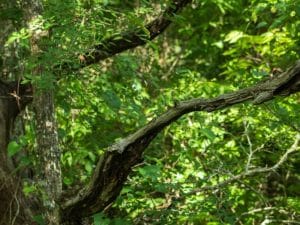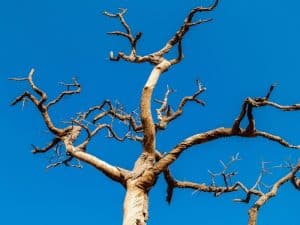Dead branches on a tree are often one of the most noticeable signs that something might be wrong. But do they necessarily mean the tree is dying? While dead branches can signal a dying tree, they don’t always mark the end. Trees, like other living organisms, experience health fluctuations. Recognising the causes of dead branches and knowing when to act is crucial for maintaining the well-being of your tree. This article will explore the common signs of a dying tree, how dead branches can affect tree health, and what you can do about it.
How can dead branches impact the overall health of a tree?
Dead branches on a tree aren’t just unsightly; they can have significant consequences for the overall health of the tree. Here’s how they can impact it:
- Disease spread: Deadwood can harbour fungi, bacteria, and pests, which can quickly spread to the healthy parts of the tree.
- Reduced nutrient flow: Dead branches often block sunlight and restrict the flow of nutrients, weakening the tree.
- Instability: As the tree struggles with dead branches, it becomes structurally weak and prone to further damage, especially in strong winds.
- Attracting pests: Dead branches are more likely to attract pests like termites, which can damage the tree’s internal structure and spread to other trees.
What are the common signs that a tree might be dying?
A tree’s health can often be determined by looking for sure signs. While dead branches are an obvious indicator, other symptoms might also suggest your tree is struggling:
- Discolouration of leaves: Yellow or brown leaves, especially when they should be green, can be a sign of stress.
- Drooping or wilted leaves: If your tree’s leaves are wilting and do not perk up after watering, this may indicate a deeper issue.
- Premature leaf drop: If leaves are falling off the tree earlier than usual, this could be a sign that the tree is under stress.
- Trunk damage: Cracks or open wounds on the trunk may expose the tree to disease.
- Poor growth: Lack of new growth or tiny leaves may indicate problems with the tree’s health.
By spotting these early signs of a dying tree, you can take the necessary steps to address the problem before it becomes a serious issue.
Why do trees develop dead branches, and what does this mean?
There are several reasons why a tree might develop dead branches, and each could have different implications for the tree’s health:
- Environmental stress: Extreme weather conditions, such as drought or heavy storms, can stress a tree and cause dead branches.
- Age: Older trees naturally shed branches over time. Dead branches can be part of the aging process.
- Pests and diseases: Insects and fungal infections can kill parts of the tree, leading to dead branches.
- Poor soil or watering practices: Incorrect soil conditions, overwatering, or underwatering can cause parts of the tree to die off.
- Injury: Physical damage from storms, pruning, or human activity can cause branches to die.
Can you save a tree with dead branches, or should it be removed?
While it’s common to worry about dead branches indicating that a tree is beyond saving, the truth is that many trees with dead branches can still be salvaged. Here’s what you can do:
- Pruning: Removing dead branches can give the tree a better chance to heal and thrive. Regular pruning can also help prevent disease and pest infestations.
- Proper care: Ensuring the tree gets enough water, sunlight, and nutrients can help it recover and prevent further branches from dying.
- Fertility and soil care: If the tree is suffering from poor soil, improving soil conditions can help it regain its strength.
What are the risks of keeping dead or damaged limbs on a tree in your yard?
Keeping dead branches on a tree poses several risks to both the tree and the surrounding environment. Here’s why it’s essential to deal with dead limbs promptly:
- Safety hazards: Dead branches can fall unexpectedly, posing a danger to people, vehicles, and structures in your yard.
- Tree health decline: Unremoved dead limbs can restrict airflow and sunlight to the rest of the tree, accelerating its decline.
- Increased pest infestation: Dead limbs can act as a breeding ground for insects like termites, which can further damage the tree and spread to other areas.
- Potential property damage: Falling branches can damage property, fences, or nearby structures, leading to costly repairs.
When should you seek professional help for tree issues like dead branches?
Sometimes, dealing with dead branches or tree issues requires the expertise of a professional arborist. Here’s when to call for help:
- When the tree is large: If the tree is too large or located in a tricky spot, it’s safer to seek professional assistance.
- When dead branches are in high-traffic areas: If the tree is near roads, homes, or playgrounds, dead branches should be addressed quickly.
- When there’s a suspected disease: If you suspect the tree has a disease, a professional arborist can diagnose and treat it correctly.
What are the benefits of regular tree inspections and arborist reports?
Regular tree inspections are essential for maintaining the health and safety of trees in your yard. Here’s why they’re essential:
- Early detection of problems: Regular inspections can catch issues like dead branches, pests, or diseases before they become severe.
- Better tree health: Arborists can provide guidance on proper care and maintenance, ensuring the tree stays strong and healthy.
- Safety: Regular inspections can help identify potential safety risks, such as unstable branches that could fall.
- Compliance with local regulations: Arborist reports can help ensure that tree removal or pruning complies with local laws and regulations.
How can tree removal services help with dying trees and damaged branches?
If your tree has too many dead branches or is beyond saving tree removal services can be your best option. Here’s how they help:
- Safe removal: Professional tree removal services ensure that the tree is safely removed without harming the property or surrounding plants.
- Stump grinding: After tree removal, stump grinding helps prevent future issues and ensures your yard is clean and usable.
- Prevention of further damage: By removing a dying tree or damaged branches, you prevent further risk to other trees, plants, and structures in your yard.
Protect your trees with expert care
At The Yard, our team of expert arborists specialises in tree removal, stump grinding, and comprehensive arborist reports. We are dedicated to ensuring the safety and health of your trees, providing reliable services across Melbourne, including the inner metro, south-east, northern, southern, eastern, and western suburbs. Whether you need to address dead branches or manage an unhealthy tree, we are here to help. Contact The Yard for all your tree care needs today!
FAQ: Do Dead Branches Indicate A Tree Is Dying?
- What do dead branches mean?
Dead branches can indicate a tree’s decline, but they don’t always mean it’s dying. They can result from stress, age, pests, or environmental factors. - How do dead branches affect a tree’s health?
Dead branches can spread disease, reduce nutrient flow, weaken the tree, and attract pests. Removing them helps maintain tree health. - What other signs suggest a tree is dying?
Look for discoloured leaves, wilting, premature leaf drop, trunk damage, or poor growth—these can indicate tree stress or decline. - Why do trees develop dead branches?
Causes include environmental stress, age, pests, disease, poor watering practices, or physical damage. - Can a tree with dead branches be saved?
Yes! Pruning dead limbs, proper care, and improving soil can help the tree recover. - What are the risks of leaving dead branches?
Risks include safety hazards from falling branches, weakened tree health, pest infestations, and potential property damage. - When should I call a professional?
If the tree is large, near high-traffic areas, or suspected to be diseased, it’s best to call an arborist for help. - Why are regular tree inspections important?
Inspections catch issues early, help maintain tree health, and ensure safety, preventing future problems. - How can tree removal services help?
Professional removal safely handles dying or damaged trees, preventing further damage and maintaining your yard. - How can I protect my trees?
Regular care, pruning, and consulting an arborist can help protect and maintain the health of your trees.




